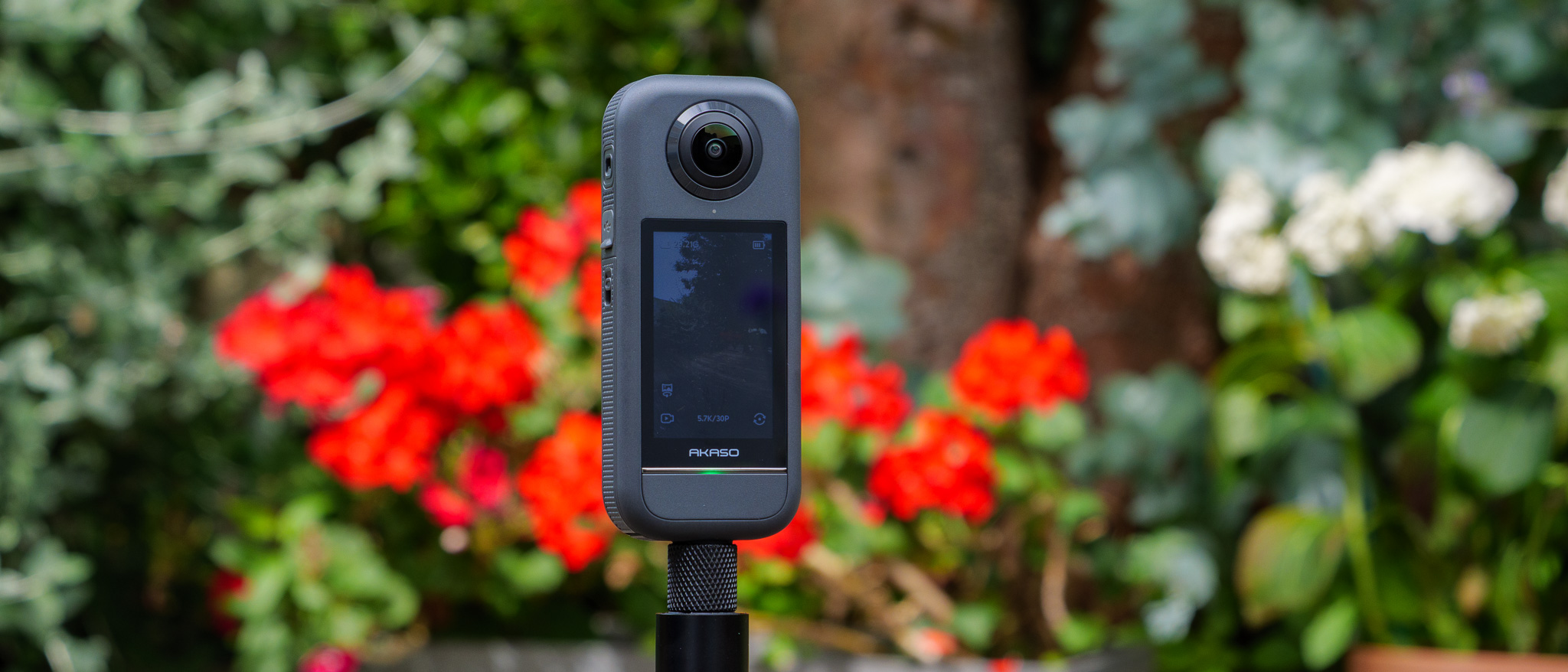Why you can trust TechRadar
We spend hours testing every product or service we review, so you can be sure you’re buying the best. Find out more about how we test.
Akaso 360: two-minute review
The Akaso 360 is the first 360-degree camera from Akaso, a company best known for its budget-friendly action cameras. And the Akaso 360 follows in that tradition, costing far less than competitors like the Insta360 X5 and GoPro Max.
Like those rivals, it’s a dual-sensor camera that shoots simultaneously on two ultra-wide lenses, automatically stitching together the images captured into a single 360-degree photo or video. These 360 images can be edited and reframed using the Akaso 360 mobile or desktop apps, before being exported for sharing or use elsewhere.
The camera can shoot stabilized 5.7K video at up to 30fps (allowing for a reframed video to be exported at up to 4K resolution), or in 4K at up to 60fps (supporting export of videos at up to 2.5K resolution), as well as still photos in JPEG and/or DNG RAW format at either 72MP or 18MP resolution.
In addition to regular 360 videos and photos, the camera offers a few special capture modes including time lapse video (where intervals can be set from one to 60 seconds), loop recording video (supporting loop durations of up to 30 minutes), bracketed HDR photos and TimeFusion, a fun mode that allows you to shoot a still from one camera then the other, before merging the two into a single image. Using it, I was able to easily create a photo in which I appeared in two different locations at once.
I’d describe the Akaso 360’s image quality as adequate rather than excellent. During my tests, if I shot videos and photos in bright sunshine I got pretty sharp and color-rich results, but at anything less than that (even on a slightly cloudy day) the camera’s 1/2-inch sensors struggled to prevent noise from creeping into the images and degrading detail. Viewing the resulting videos on my phone screen, they looked pretty decent – but on my computer’s larger screen the noise was very noticeable.
The Insta360 X5 and Insta360 X4, two other 360 cameras I’ve tested fairly recently, far surpass what the Akaso 360 is capable of, image quality-wise – but they’re also far more expensive. For a camera in its price range, I think its performance is definitely acceptable, and its built-in quality-of-life features such as video stitching and selfie stick removal work very well.
The mobile and desktop editing apps are simple but intuitive to use, and once you’ve imported the videos from the camera to either a phone or computer, trimming and reframing them using either AI-assisted subject tracking or manually added keyframes is a fast and easy process. There are basic image adjustment settings here too, but for the purposes of the sample videos embedded here I left things untouched to give an accurate representation of what you can expect straight out of the camera.
Videos and photos are stored on a microSD card, with capacities up to 512GB supported; card speeds must be UHS-I V30, UHS-I Class 3 (US) or above. I’ll say from my own experience that the camera could benefit from a faster wireless connection. Some of the file sizes of these 360 videos are very large, and transferring them via standard Wi-Fi with a maximum speed of around 12MB per second can take a long time.
The camera also features a built-in stereo microphone, which works well enough indoors or in calm conditions. Like most unmuffled camera mics, it picks up wind noise outdoors very easily, so can’t really be relied on blustery days, or for fast action such as biking.
Speaking of the weather, one thing potential buyers would do well to note about the Akaso 360 is that, unlike the Insta360 X5 or GoPro Max, it isn’t rated as waterproof, dustproof or ruggedized. Akaso call it “splash-resistant”, and I used it during a light rain shower with no ill effects aside from some droplets on the lens appearing in shot; dunking it fully underwater certainly wouldn’t be advisable, however. There’s also no easy solution to fixing scratched or broken lenses, unlike the X5’s user-replaceable glass.
That being said, I found the Akaso 360’s general design, controls and handling to be fine, aside from one niggle: the touchscreen all-too stubbornly resisted my swipes and taps, which sometimes made for an annoying experience when trying to change video settings and the like. The physical buttons, screen size and clarity and the camera’s compact size and low weight are all impressive, and its candy bar shape (very much like a slightly smaller Insta360 X5) is perfectly pocketable.
Battery life is also acceptable, with my stress testing allowing for around 50 minutes of 5.7K 30fps video to be recorded using a fully charged battery – just a little shy of the 60 minutes claimed by Akaso. Reassuringly, while the camera got very warm during this test (it was a hot summer’s day and the ambient temperature in my home office was toasty), it never overheated to the point where it stopped recording and shut itself down to cool off.
Akaso 360 specs
|
Type: |
360 camera |
|
Sensor: |
1/2-inch x 2 |
|
Focal length: |
7.6mm |
|
Max aperture: |
f/2.25 |
|
Dimensions: |
46.9 x 109.8 x 30.8mm |
|
Weight: |
6.3oz / 180g |
Akaso 360: price and availability
- Launched worldwide on 7 July 2025
- Standard Combo costs $199.99 / £199.99 / AUS329.99
- Creator Combo also available for $249.99 / £249.99 / AU$399.99
Launched on 7 July 2025, the Akaso 360 is available to buy in two bundles: the Standard Combo and Creator Combo.
The Standard Combo (which I was sent for the purposes of this review) costs $199.99 / £199.99 / AUS329.99 and features the camera, a protective pouch, two batteries, one USB-C cable, one lens cleaning cloth and a quick-start guide. The Creator Combo costs $249.99 / £249.99 / AU$399.99 and comes with all of the above plus a further two batteries, a battery charging case and a 120cm selfie stick.
This is a lot cheaper than the current competition. The GoPro Max costs from $349.99 / £349.99 / AU$599.95 while the Insta360 X5 costs from $549.99 / £519.99 / AU$929.99. Even if you go back to last year’s Insta360 X4, it’s at least $349.99 / £425.99 / $632.99, so Akaso has a really compelling selling point compared to its main rivals.
Should I buy the Akaso 360?
Buy it if…
You want the best affordable 360 camera
With Insta360 and GoPro’s current 360 cameras costing a lot more, the Akaso 360 represents a fantastic alternative for those on a tighter budget.
You want a simple 360 camera
The Akaso 360 does its main jobs well, stitching together videos seamlessly and removing selfie sticks from its footage. It’s not packed with advanced features but it’s a reliable performer.
Don’t buy it if…
You need a rugged 360 camera
It’s not waterproof, dustproof or shockproof, so the Akaso 360 isn’t the best camera for documenting your wet and/or wild outdoors adventures.
You want the best 360 image quality
The Akaso 360’s footage is decent but falls down in low light. For truly excellent 360 video in all conditions, we’d recommend the Insta360 X5, which has large sensors and effective noise reduction processing.
Also consider
While it’s no longer listed as a current model on Insta360’s website, this 2023-released 360 camera is still on sale in plenty of places – and for less than ever. While it lacks some of the advanced features of newer models, it’s capable of great-looking, simple-to-capture 360 videos, and unlike the Akaso 360 supports Active HDR to temper blown-out highlights and increase shadow detail.
Read our in-depth Insta360 X3 review
We’re still waiting for a real GoPro Max 2, but this recently refreshed edition cuts GoPro’s original 360 camera’s price while making some modest updates to its hardware in the form of improved battery life and more mounting options. While GoPro has ceded ground to Insta360 at the higher end of the 360 market, this mid-range 360 camera still has plenty to offer.
How I tested the Insta360 X5
- Tested for several days, full production model running release firmware
- Camera mounted on invisible selfie stick
- Recorded videos on foot and bicycle
I was sent a sample of the Akaso 360 ahead of its release, giving me a week or so to test the camera (running the latest firmware I could download) ahead of its launch. I was able to capture videos and photos indoors at home, plus outside both on foot (for vlog-style content) and on my bike (for more action-type stuff). I edited footage using Akaso’s own apps, using both the mobile app and the MacOS desktop app to put together the sample videos you see above.
Read the full article here















